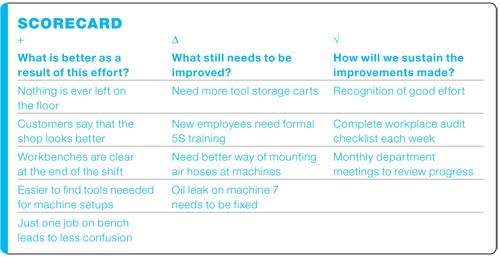A Simple Technique For Evaluating Success
Continuous improvement requires that we analyze current practices and identify ways to do them better, faster and cheaper. Yet, have you ever found yourself asking if your actions have really made a difference? In some cases, improvements are obvious and easily measured using dollars saved, downtime reduced, increased yield rate or any number of worthwhile quantitative metrics. However, sometimes the improvements are not so easy to measure quantitatively.
Share




Continuous improvement requires that we analyze current practices and identify ways to do them better, faster and cheaper. Yet, have you ever found yourself asking if your actions have really made a difference? In some cases, improvements are obvious and easily measured using dollars saved, downtime reduced, increased yield rate or any number of worthwhile quantitative metrics.
However, sometimes the improvements are not so easy to measure quantitatively. In this case, you need something of a qualitative nature to evaluate whether your efforts have succeeded in making things better. One technique I have
found useful is what I call a "Plus-Delta-Check Scorecard."
The "Plus-Delta-Check Scorecard" relies on input from the stakeholders, or those involved in the process we have tried to improve. Understanding how these stakeholders perceive the changes made can tell us a lot about whether our efforts have, indeed, been successful. A major benefit of this scorecard is that it can provide information relatively quickly, enabling us to either continue along as planned or explore alternative courses of action. The "Plus-Delta-Check Scorecard" is especially effective for initiatives such as improving workplace organization and streamlining administrative processes, which may be difficult to quantify using traditional techniques.
As the name implies, the "Plus-Delta-Check Scorecard" seeks to capture the positives (+) that have resulted from the continuous improvement effort, the changes (Δ) that still need to be made and the checks (√) that will be used to ensure the improvements are sustained going forward. The scorecard is employed when the improvement effort is substantially underway and when there should be some evidence of improvement.
In practice, the stakeholders of the process are presented with the three scorecard questions. Rather than providing general responses to these questions, the stakeholders are asked to offer as many specifics as possible. Let’s take a look at the scorecard questions in light of how they might be used to determine the success of a company’s workplace organization improvement effort.
Plus (+)—What is better as a result of this effort? Rather that accepting an answer of "The department is better organized," we need to probe for specifics. What exactly has the improved organization done for the people working in the department? Ideally, we might hear answers such as "I no longer have to leave my department to get supplies," or "I can find the tools required to set up a machine much faster," or even "I now can easily see which container is for scrap material and which is for trash." If we are able to pose our questions thoughtfully enough, then we might even hear some surprising answers, such as one I heard recently at a company I was working with: "What used to take me 20 minutes to find, now takes me 10 seconds."
Delta (Δ)—What changes/improvements still need to be made? Even after progress is made and benefits are seen, there may be some things that need further attention. Probe the stakeholders to identify what still needs to be done or what is not working as expected. Hearing comments like "Not everyone is following the department standards we established," or "We still don’t have enough tools, and people are borrowing and not returning," is a good indication that more effort is required. Allowing the stakeholders to offer open and honest feedback gets issues out on the table and is critical to achieving success (rather than just hoping for it).
Check (√)—How will we check to ensure the gains made will be sustained? This is an important question as it addresses the level of commitment to maintaining the benefits that have been achieved. If things are not checked, there is always the risk of backsliding. Responses that indicate a plan to audit progress and a willingness to take corrective action when needed should provide a sense that this commitment is present in the stakeholders.
A "Plus-Delta-Check Scorecard" is a simply effective tool that just might help you determine how successful your improvement effort has been.
The chart above is an example of a "Plus-Delta-Check Scorecard" that was completed four weeks into one company’s effort to improve workplace organization.
Read Next
Registration Now Open for the Precision Machining Technology Show (PMTS) 2025
The precision machining industry’s premier event returns to Cleveland, OH, April 1-3.
Read MoreBuilding Out a Foundation for Student Machinists
Autodesk and Haas have teamed up to produce an introductory course for students that covers the basics of CAD, CAM and CNC while providing them with a portfolio part.
Read MoreSetting Up the Building Blocks for a Digital Factory
Woodward Inc. spent over a year developing an API to connect machines to its digital factory. Caron Engineering’s MiConnect has cut most of this process while also granting the shop greater access to machine information.
Read More






























